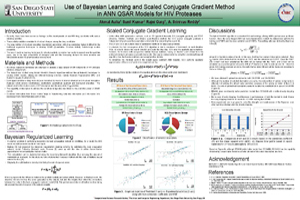 |
||||||||
 |
 |
 |
 |
 |
| Use of Bayesian Learning Versus Scaled Conjugate Gradient Method in ANN QSAR Models for HIV Proteases | ||
|
Recently, there have been numerous findings on
the developments of new HIV drug candidates with various inhibitory
activities. These activity variation correlates to structural changes
among the drug candidates. Studies involving constitutional, electrostatic,
geometrical, quantum, and topological descriptors correlated with
the activity are called Quantitative Structural Activity Relationship
(QSAR). The large number of both the drug candidates and the associated
descriptors makes it difficult for the traditional regression techniques
to handle the data accurately in QSAR. Thus, it is necessary to
use other methods to gain insights about these relationships. The
use of machine learning techniques for structure-activity correlation
has vastly increased over the past few years, due to the high accessibility
of biological data and the increasing demand for more
| ||
|
accurate and interpretable models for pharmaceutical
development. This poster aims to present QSAR study on a class of
HIV protease inhibitors utilizing evolutionary computation (Genetic
Algorithms) and machine learning techniques (Neural Networks). In
this study, comparison studies were performed, applying two different
learning schemes for Neural Network training, namely Bayesian regularization
and scaled conjugate gradient. Our results illustrates that, although
the Bayesian regularization has more time complexity, it has better
accuracy than the results obtained using scaled conjugate gradient.
|
||
| • Other Abstracts • | ||
